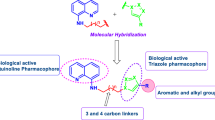Abstract
Novel series of quinaxoline derivatives incorporating N-propionic and O-propionic hydrazide moieties were synthesized. Alkylation of 3-methylquinoxalin-2(1H)-one with ethyl 2-bromopropanoate afforded a mixture of O-alkylated and N-alkylated 3-methylquinoxaline. Hydrazide derivatives were afforded by reaction of O-alkylated and N-alkylated 3-methylquinoxaline with hydrazine hydrate. Condensation of hydrazide derivatives with different aromatic aldehydes and formylpyrazoles afforded the corresponding hydrazone derivatives. The synthesized quinaxoline derivatives were evaluated for their expected antimicrobial activity; where, the majority of these compounds showed potent antibacterial and antifungal activities against the tested strains of bacteria and fungi. Hydrazone derivative which contain 3-p-tolyl-pyrazolyl moiety showed fourfold potency of amphotericin B in inhibiting the growth of Aspergillus fumigatus, twofold potency of gentamycin in inhibiting the growth of Neisseria gonorrhoeae, equipotent potency of ampicillin in inhibiting the growth of Streptococcus pyogenes, equipotent potency of gentamycin in inhibiting the growth of Proteus vulgaris and Shigella flexneri, equipotent potency of amphotericin B in inhibiting the growth of Aspergillus clavatus, Geotrichum candidum and Penicillium marneffei. Thus, these studies suggested that quinaxoline derivatives bearing a pyrazole moiety are interesting scaffolds for the development of novel antibacterial and antifungal agents.






Similar content being viewed by others
References
Abbas H-AS, Al-Marhabi ARM, Eissa SI, Ammar YA (2015) Molecular modeling studies and synthesis of novel quinoxaline derivatives with potential anticancer activity as inhibitors of c-met kinase. Bioorg Med Chem 23:6560–6572
Abbas SY, Basyouni WM, El-Bayouk KAM (2018) Synthesis, characterization and antimicrobial activity of 5-(arylazo) salicylaldimines and their copper (II) complexes. Appl Organomet Chem 32:e4032
Abbas SY, El-Sharief AM, Basyouni WM, Fakhr IMI, El-Gammal EW (2013) Thiourea derivatives incorporating a hippuric acid moiety: synthesis and evaluation of antibacterial and antifungal activities. Eur J Med Chem 64:111–120
Al-Marhabi AR, Abbas H-AS, Ammar YA (2015) Synthesis, characterization and biological evaluation of some quinoxaline derivatives: a promising and potent new class of antitumor and antimicrobial agents. Molecules 20:19805–19822
Amin KM, Ismail MMF, Noaman E, Soliman DH, Ammar YA (2006) New quinoxaline-1,4-di-N-oxides (part1): hypoxia-selective cytotoxine and anticancer agents derived from quinoxaline-1,4-di-N-oxides. Bioorg Med Chem 14:6917–6923
Ammar YA, El-Sharief MAMS Ghorab MM, Mohamed YA, Ragab A, Abbas SY (2016) New Imidazolidineiminothione, imidazolidin-2-one, and imidazoquinoxaline derivatives: synthesis and evaluation of antibacterial and antifungal activities. Cur Org Syn 13:466–475
Angelova VT, Valcheva V, Vassilev NG, Buyukliev R, Momekov G, Dimitrov I, Saso L, Djukic M, Shivachev B (2017) Antimycobacterial activity of novel hydrazide-hydrazone derivatives with 2H-chromene and coumarin scaffold. Bioorg Med Chem Lett 27:223–227
Coa JC, Castrillon W, Cardona W, Carda M, Ospina V, Munoz JA, Velez ID, Robledo SM (2015) Synthesis, leishmanicidal, trypanocidal and cytotoxic activity of quinoline-hydrazone hybrids. Eur J Med Chem 101:746–753
Cooper RE (1972) In: Kavangeh FW (ed) Analytical microbiology, vols 1 & 2. Academic Press, New York, NY and London
El Shehry MF, Ghorab MM, Abbas SY, Fayed EA, Shedid SA, Ammar YA (2018) Quinoline derivatives bearing pyrazole moiety: synthesis and biological evaluation as possible antibacterial and antifungal agents. Eur J Med Chem 143:1463–1473
El-Sharief MAMS, Abbas SY, Zahran MA, Mohamed YA, Ragab A, Ammar YA (2016) New 1,3-diaryl-5-thioxo-imidazolidin-2,4-dione derivatives: synthesis, reactions and evaluation of antibacterial and antifungal activities. Z Naturforsch B 71:875–881
Fouad SA, Hessein SA, Abbas SY, Farrag AM, Ammar YA (2018) Synthesis of chromen-2-one, pyrano[3,4-c]chromene and pyridino [3,4-c] chromene derivatives as potent antimicrobial agents. Croat Chem Acta 91:99–107
Hessein SA, El-Sharief MAM, Abbas SY, Thabet HK, Ammar YA (2016) Synthesis and antimicrobial activity of furochromone, benzofuran and furocoumarin derivatives bearing sulfonyl moiety. Croat Chem Acta 89:91–100
Islam MS, Park S, Song C, Kadi AA, Kwon Y, Motiur Rahman AFM (2017) Fluorescein hydrazones: a series of novel non-intercalative topoisomerase IIa catalytic inhibitors induce G1 arrest and apoptosis in breast and colon cancer cells. Eur J Med Chem 125:49–67
Ismail MMF, Amin KM, Noaman E, Soliman DH, Ammar YA (2010) New quinoxaline-1,4-di-N-oxides: anticancer and hypoxia-selective therapeutic agents. Eur J Med Chem 45:2733–2738
Kauthale S, Tekale S, Damale M, Sangshetti J, Pawar R (2017) Synthesis, antioxidant, antifungal, molecular docking and ADMET studies of some thiazolyl hydrazones. Bioorg Med Chem Lett 27:3891–3896
Moussa Z, El-Sharief MAMS, Abbas SY (2016) New imidazolidineiminothione derivatives: synthesis, spectral characterization and evaluation of antitumor, antiviral, antibacterial and antifungal activities. Eur J Med Chem 122:419–428
Palace-Berl F, Pasqualoto KFM, Zingales B, Moraes CB, Bury M, Franco CH, Neto ALS, Murayama JS, Nunes SL, Silva MN, Tavares LC (2018) Investigating the structure-activity relationships of N’-[(5-nitrofuran-2-yl) methylene] substituted hydrazides against Trypanosoma cruzi to design novel active compounds. Eur J Med Chem 144:29–40
Senkardes S, Kaushik-Basu N, Durmaz I, Manvar D, Basu A, Atalay R, Küçükgüzel SG (2016) Synthesis of novel diflunisal hydrazide-hydrazones as anti-hepatitis C virus agents and hepatocellular carcinoma inhibitors. Eur J Med Chem 108:301–308
Yang L, Wang P, Wu J-F, Yang L-M, Wang R-R, Pang W, Li Y-G, Shen Y-M, Zheng Y-T, Li X (2016) Design, synthesis and anti-HIV-1 evaluation of hydrazide-based peptidomimetics as selective gelatinase inhibitors. Bioorg Med Chem 24:2125–2136
Yang Z-B, Hu D-Y, Zeng S, Song B-A (2016) Novel hydrazone derivatives containing pyridine amide moiety: design, synthesis, and insecticidal activity. Bioorg Med Chem Lett 26:1161–1164
Author information
Authors and Affiliations
Corresponding authors
Ethics declarations
Conflicts of interest
The authors declare that there is no conflict of interest.
Electronic supplementary material
Rights and permissions
About this article
Cite this article
El Shehry, M.F., Abbas, S.Y., Farrag, A.M. et al. Design, synthesis and biological evaluation of quinoxaline N-propionic and O-propionic hydrazide derivatives as antibacterial and antifungal agents. Med Chem Res 27, 2287–2296 (2018). https://doi.org/10.1007/s00044-018-2235-4
Received:
Accepted:
Published:
Issue Date:
DOI: https://doi.org/10.1007/s00044-018-2235-4




